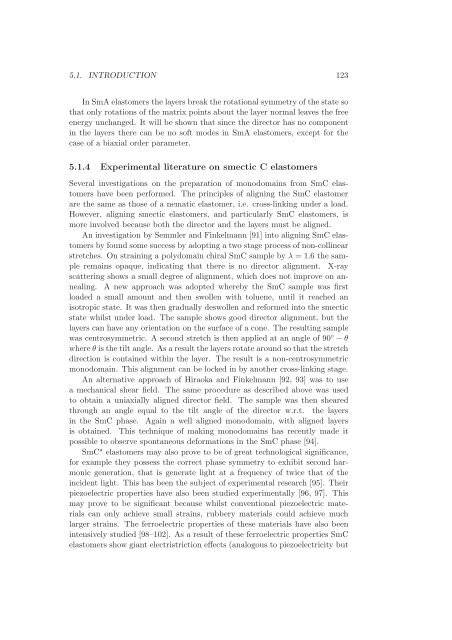Statistical models of elasticity in main chain and smectic liquid ...
Statistical models of elasticity in main chain and smectic liquid ...
Statistical models of elasticity in main chain and smectic liquid ...
Create successful ePaper yourself
Turn your PDF publications into a flip-book with our unique Google optimized e-Paper software.
5.1. INTRODUCTION 123InSmAelastomers thelayers break therotational symmetry<strong>of</strong> thestate sothat only rotations <strong>of</strong> the matrix po<strong>in</strong>ts about the layer normal leaves the freeenergy unchanged. It will be shown that s<strong>in</strong>ce the director has no component<strong>in</strong> the layers there can be no s<strong>of</strong>t modes <strong>in</strong> SmA elastomers, except for thecase <strong>of</strong> a biaxial order parameter.5.1.4 Experimental literature on <strong>smectic</strong> C elastomersSeveral <strong>in</strong>vestigations on the preparation <strong>of</strong> monodoma<strong>in</strong>s from SmC elastomershave been performed. The pr<strong>in</strong>ciples <strong>of</strong> align<strong>in</strong>g the SmC elastomerare the same as those <strong>of</strong> a nematic elastomer, i.e. cross-l<strong>in</strong>k<strong>in</strong>g under a load.However, align<strong>in</strong>g <strong>smectic</strong> elastomers, <strong>and</strong> particularly SmC elastomers, ismore <strong>in</strong>volved because both the director <strong>and</strong> the layers must be aligned.An <strong>in</strong>vestigation by Semmler <strong>and</strong> F<strong>in</strong>kelmann [91] <strong>in</strong>to align<strong>in</strong>g SmC elastomersby found some success by adopt<strong>in</strong>g a two stage process <strong>of</strong> non-coll<strong>in</strong>earstretches. On stra<strong>in</strong><strong>in</strong>g a polydoma<strong>in</strong> chiral SmC sample by λ = 1.6 the samplerema<strong>in</strong>s opaque, <strong>in</strong>dicat<strong>in</strong>g that there is no director alignment. X-rayscatter<strong>in</strong>g shows a small degree <strong>of</strong> alignment, which does not improve on anneal<strong>in</strong>g.A new approach was adopted whereby the SmC sample was firstloaded a small amount <strong>and</strong> then swollen with toluene, until it reached anisotropic state. It was then gradually deswollen <strong>and</strong> reformed <strong>in</strong>to the <strong>smectic</strong>state whilst under load. The sample shows good director alignment, but thelayers can have any orientation on the surface <strong>of</strong> a cone. The result<strong>in</strong>g samplewas centrosymmetric. A second stretch is then applied at an angle <strong>of</strong> 90 ◦ −θwhereθ isthetilt angle. Asaresultthelayers rotatearoundsothatthestretchdirection is conta<strong>in</strong>ed with<strong>in</strong> the layer. The result is a non-centrosymmetricmonodoma<strong>in</strong>. This alignment can be locked <strong>in</strong> by another cross-l<strong>in</strong>k<strong>in</strong>g stage.An alternative approach <strong>of</strong> Hiraoka <strong>and</strong> F<strong>in</strong>kelmann [92, 93] was to usea mechanical shear field. The same procedure as described above was usedto obta<strong>in</strong> a uniaxially aligned director field. The sample was then shearedthrough an angle equal to the tilt angle <strong>of</strong> the director w.r.t. the layers<strong>in</strong> the SmC phase. Aga<strong>in</strong> a well aligned monodoma<strong>in</strong>, with aligned layersis obta<strong>in</strong>ed. This technique <strong>of</strong> mak<strong>in</strong>g monodoma<strong>in</strong>s has recently made itpossible to observe spontaneous deformations <strong>in</strong> the SmC phase [94].SmC ⋆ elastomers may also prove to be <strong>of</strong> great technological significance,for example they possess the correct phase symmetry to exhibit second harmonicgeneration, that is generate light at a frequency <strong>of</strong> twice that <strong>of</strong> the<strong>in</strong>cident light. This has been the subject <strong>of</strong> experimental research [95]. Theirpiezoelectric properties have also been studied experimentally [96, 97]. Thismay prove to be significant because whilst conventional piezoelectric materialscan only achieve small stra<strong>in</strong>s, rubbery materials could achieve muchlarger stra<strong>in</strong>s. The ferroelectric properties <strong>of</strong> these materials have also been<strong>in</strong>tensively studied [98–102]. As a result <strong>of</strong> these ferroelectric properties SmCelastomers show giant electristriction effects (analogous to piezoelectricity but
















